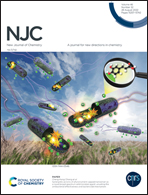Achieving tricolor luminescence switching from a stimuli-responsive luminophore based on a bisarylic methanone derivative†
Abstract
A new, D–A type bisarylic methanone π-architecture named DBF-BZ-TPA with a carbonyl group as an electron acceptor and triphenylamine as an electron donor is designed and synthesized. Single-crystal X-ray analysis shows that the hydrogen bonding and intermolecular π–π interactions, and the highly distorted molecular conformations in the resulting crystals endow DBF-BZ-TPA with a high-contrast mechanofluorochromic (MFC) nature and intense fluorescence in the solid state. The as-prepared DBF-BZ-TPA solids exhibit bright sky-blue emission (465 nm). After grinding, ground solids with yellow fluorescence (535 nm) are obtained, and thus, a spectral red shift of 70 nm is observed. When the ground powders are fumed using DCM vapor or annealed at 150 °C, yellow-green-emitting solids (YG-powders, approximately 500 nm) are obtained. This results in tricolor luminescence switching. PXRD, DSC, fluorescence lifetime, and spectral analyses indicate that the MFC behavior of DBF-BZ-TPA may be the result of the phase transition between the crystalline and amorphous phases, and the red shift in the PL spectrum comes from the smaller band gap induced by the planar intramolecular charge transfer (PICT) and the increased π–π interactions, the increase of exciton coupling, and the increased orbital overlap between neighboring molecules.



 Please wait while we load your content...
Please wait while we load your content...